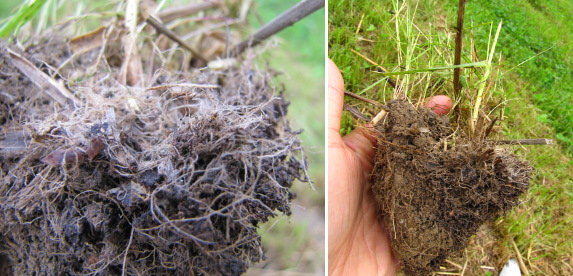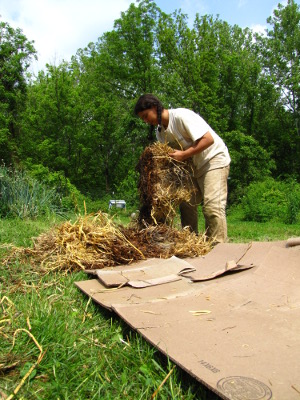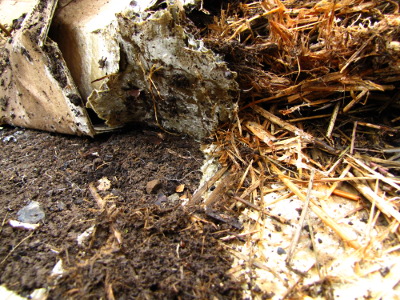
Kill-mulching annual ryegrass

 The
good news is --- I'm very happy with my annual
ryegrass cover crop.
The bad news is --- I really couldn't manage to keep all those beds
fallow for more than three months. I just wanted extra this and
that, and decided to steal back about half the fallow space for
succession planting in the midsummer garden.
The
good news is --- I'm very happy with my annual
ryegrass cover crop.
The bad news is --- I really couldn't manage to keep all those beds
fallow for more than three months. I just wanted extra this and
that, and decided to steal back about half the fallow space for
succession planting in the midsummer garden.
We haven't been managing
the ryegrass optimally, but it has held up well under some abuse.
You're supposed to let the grass grow pretty tall (just short of bloom)
and then mow the plants down to four inches, but I've been letting Mark
treat the ryegrass like part of the lawn. That means he cuts the
ryegrass pretty short at pretty frequent intervals, but it has always
bounced back.
As you can see from the
photos at the top of this post, the root structure of annual ryegrass
is pretty inspiring. People often use the plant to hold soil in
place after construction projects, and I noticed the brilliant
yellow-green along our country roads in a few places last fall
once I knew what to look for. I'm always guessing at the effects
of cover crops since I'm too lazy to measure organic matter content in
the beds before and after, but I know these copious roots can only help
my problematic clay as they decompose.
Since I'll need some of
the ryegrass beds in about a month, I waited until after Mark mowed,
then laid down a simple kill
mulch of cardboard
and straw. I consider kill mulches  a tool for the lazy gardener
since they're so easy, but (unlike most things we do out of laziness),
kill mulches really pay off in the health of the soil. This last
photo shows a weed-covered bed I kill mulched instead of weeded a
couple of months ago --- the cardboard has degraded enough that I can
tear right through it, there's mycelium everywhere, and the worms fled
by the dozen as I cleared a path for sunflower seeds. If my
ryegrass beds look half that good at planting time in a month, I'll be
thrilled.
a tool for the lazy gardener
since they're so easy, but (unlike most things we do out of laziness),
kill mulches really pay off in the health of the soil. This last
photo shows a weed-covered bed I kill mulched instead of weeded a
couple of months ago --- the cardboard has degraded enough that I can
tear right through it, there's mycelium everywhere, and the worms fled
by the dozen as I cleared a path for sunflower seeds. If my
ryegrass beds look half that good at planting time in a month, I'll be
thrilled.
Want more in-depth information? Browse through our books.
Or explore more posts by date or by subject.
About us: Anna Hess and Mark Hamilton spent over a decade living self-sufficiently in the mountains of Virginia before moving north to start over from scratch in the foothills of Ohio. They've experimented with permaculture, no-till gardening, trailersteading, home-based microbusinesses and much more, writing about their adventures in both blogs and books.
Want to be notified when new comments are posted on this page? Click on the RSS button after you add a comment to subscribe to the comment feed, or simply check the box beside "email replies to me" while writing your comment.
